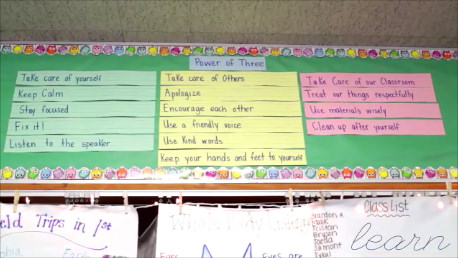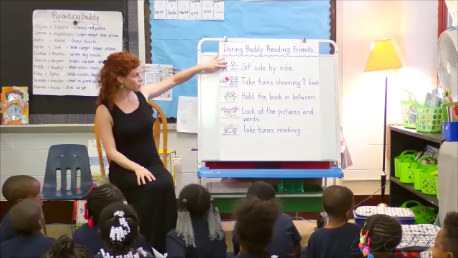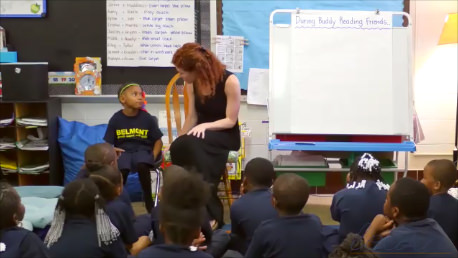Classroom Culture
 We all want our children to be self-directed learners. But moving them towards independence is not an easy task. We should never assume children know how to be independent. As educators, we should help facilitate as many opportunities for our children to be self-directed and independent throughout their school day as possible. We should take time to observe and look for ways to help grow their independence. We should recognize and acknowledge what children can do and then consider how we can alter or enhance the environment, the activities, and the structure of the classroom to support increased independence and engagement.
We all want our children to be self-directed learners. But moving them towards independence is not an easy task. We should never assume children know how to be independent. As educators, we should help facilitate as many opportunities for our children to be self-directed and independent throughout their school day as possible. We should take time to observe and look for ways to help grow their independence. We should recognize and acknowledge what children can do and then consider how we can alter or enhance the environment, the activities, and the structure of the classroom to support increased independence and engagement.
Remember, the ability to work independently varies based on a number of factors such as your children’s cognitive ability, language ability, and maturity. Expecting a first grader to remain engaged for one hour at the beginning of the year may not be reasonable. But we must keep in mind that if we want children to work independently, we need to give them tasks that are worthwhile to do, not just to keep them busy while we meet with small groups. The work children are doing must be engaging and purposeful.
Procedures are one crucial element in supporting children’s ability to work independently. Are your procedures like rituals in your room? Are they carried through the same way every time? Do your children know exactly what it looks like and sounds like to follow the procedure successfully? Could they do it without your support? And can they almost do it with their eyes closed?
What Procedures Should I Teach?
Teaching Procedures for Independent Work Time
Learn how to teach effective and meaningful procedures that your class can use during Independent Work Time.
Here is a list of procedures that will no doubt make your top priority list!
- How to use appropriate voice levels
- Understanding teacher designated signals (e.g. 1 finger - tissue, 2 fingers – need materials, 3 – need adult help, etc.)
- How to transition from one activity/station to the next
- How to solve a problem (e.g. broken pencil, run out of supplies, someone hurts your feelings)
- How to take turns and/or decide who goes first
- How to share materials
- Finding and using different materials for the activity (e.g. pencils, paper, scissors, books)
- How to self-assess through a rubric
- How to hand in work, if needed
- How to make choices at a center (e.g. different options for the task, paper choices, etc.)
- When to report vs. tattle
When you scope out the sequence of the lessons associated with procedures, consider what background information and language the children will need to be familiar with in order meet your expectations.
- What will children need to learn in order to be responsible? (examples: Where materials are, how to take care of markers, how to handle and pass scissors, how to use glue, how to handle books, how to pass out papers, how and when to sharpen pencils, etc.)
- Can they learn it in one lesson?
- How many lessons will this take (make an estimate)?
- How could we break down this idea into a series of steps or lessons so the children can truly become responsible for this?
What Makes Procedures Effective?
 Teach procedures for anything you want children to be able to do independently. Make sure routines and procedures are:
Teach procedures for anything you want children to be able to do independently. Make sure routines and procedures are:
Specific
The language we use to implement the particular procedure should be specific, not general. For example, a general procedure might be “how to take care of our supplies” but a more specific procedure would be “what to do if my pencil breaks.” When you are more specific, children have a better understanding of what to expect and what to do.
Planned
Use a lesson planning template to make sure you are not just telling the procedure but actually teaching the procedure, just like we teach math and reading - step by step.
Modeled and Practiced
Spend the time to plan, model, rehearse, and reinforce every aspect of Independent Work Time. Each procedure is important and should be valued by all learners in the community and explicitly discussed. It takes 21 days for a habit to form! And it takes a similar amount of time for a child to learn new language as tied to a specific behavior. That’s a lot of practicing and worthwhile repetition!
Posted
Anchor charts should be made with the children and reinforced daily or as needed. Each center should have a poster or list of activities and tasks. The charts should be displayed in the area that makes sense. For example, a chart entitled “How to Use the Library” should be displayed in the classroom library.
Consistent
Children need structure and so there needs to be a consistency in how procedures are modeled and practiced. Procedures should be carried out the same way every time.
Teaching Procedures
 When you are teaching procedures, it helps if children know what they are learning and why it is important to the classroom community. They’ll need to see the procedure in action and have a chance to try it out. Use the following steps to plan and teach your procedures.
Taking the time to carefully plan your procedures will result in more meaningful and clearer instruction later. Use a lesson plan template to write down what you will say and do with your children to teach procedures.
When you are teaching procedures, it helps if children know what they are learning and why it is important to the classroom community. They’ll need to see the procedure in action and have a chance to try it out. Use the following steps to plan and teach your procedures.
Taking the time to carefully plan your procedures will result in more meaningful and clearer instruction later. Use a lesson plan template to write down what you will say and do with your children to teach procedures.
|
Build Importance
Teach
|
Practice
Recap
|
Lesson Planning Template
The lesson planning template is your partner in planning a successful procedural lesson. The template is equipped with helpful prompts that focus your attention and support your thinking through the planning of each lesson component. If you need more support, take a look at our “notes” version of the template.
Responsibilities and Procedures Planning Template
Use this template to guide your lesson planning when you are teaching procedures.
Procedures Planning Template with Notes
This annotated version of our planning template explains each step of the lesson planning process.
Sample Lesson Plans
Here are a few sample lesson plans to teach responsibilities and procedures during Independent Work Time. Feel free to adapt them to meet the needs of your children.
Sample Lesson - Sorting Words - K
This sample lesson reviews how to sort words at the ABC Center.
Sample Lesson - Retelling with Puppets - K
This sample lesson teaches how to retell a story using stick puppets.
Sample Lesson - Buddy Reading - 1
This sample lesson teaches children how to read with a partner.
Sample Lesson - Building Words - 1
This sample lesson reviews how to use onset and rime to make words.
Sample Lesson - Reading with Expression - 2
This sample lesson explains how to use the new poetry center.
Sample Lesson - Reading the Room - 2
This sample lesson describes how to search for multi-syllabic words in environmental print.
Sample Lesson - Word Search - 3
This sample lesson describes how to go on a word hunt through magazines.
Sample Lesson - Reading Response - 3
This sample lesson explains how to choose a graphic organizer to compose a reading response.
Building Motivation
Motivation is defined as intrinsic desire to initiate, sustain, and direct one’s activity. Motivated children return to and continue to work on tasks. What builds motivation?
One primary way you can build motivation in children is through choice. Choice gives children a sense of control and promotes motivation, which in turn leads to greater levels of child engagement. Choice as a basic classroom principle motivates children and builds a greater desire to learn – to persevere.
As teachers we are used to “owning” the clock, the schedule, etc. Trust plays a role in allowing children choice. Making this shift to incorporating more choice may require us to adjust our expectations. As The Sisters say in The Daily 5, “Trusting children is the underpinning of what makes…any structure for teaching children to manage themselves independently work.” When trust is combined with explicit instruction, children can acquire the skills necessary to become independent learners. When offering children choices, consider how and when it makes sense for them to do so. They may not have a choice in rejecting the tenets of your positive classroom culture but they can make choices around the following:
- Content: topics to research and write about books to read
- Process: materials, spaces to sit to read and write, whom they might work with (partner)
- Products: book report, story map, oral presentation, etc.
Another important way that you can build motivation is through offering children opportunities to collaborate. Collaboration not only facilitates children’s engagement, it’s crucial for children’s oral language development.
If growing independent readers and writers is our goal, then we need to create “talking” classrooms, not silent ones. We need to encourage and support children to participate fully in thoughtful conversations with us and their classmates.
Transitions
Transition times are those times when children are moving to or from a center or cleaning up. These can be tricky for many reasons. For example, children may not be ready to move to the next center or they may not know where they are supposed to go to next. You can help your children by teaching clear, consistent procedures and routines. Aim to keep your transition time to a minimum with these helpful tips:
- Use the same transition signal each time!
- Model all the procedures around transitions you want the children to learn. Let them rehearse the procedures around transitions and give them plenty of time for practice.
- Prepare children for transition. Let the children know that a transition is coming. For example, you can provide a verbal cue such as “Five minutes until center time is over.” Or you can use a nonverbal cue such as a rain stick or another pleasing sound as a signal.
- When transitioning, teach children relevant songs keep them engaged and also to signal how long a transition should take (the length of the song). For example, teach the children that singing the “Clean Up Song” twice while cleaning up after snack time should be all the time that is needed.
- Support children who need extra assistance with transitions. This is a tricky time for many children (and grownups!). You can use photographs to help them know what activity will be next or what order to get ready for the next activity. You might also give them individualized support such as a personal reminder or a transition buddy. The goal is to help children feel successful as you move them towards independence.
- Incorporate your children’s home languages to aid in transitions. Use some of the key words in their home language if this will help them know what to expect (e.g. words for “bathroom” or “lunch”). Identify key transitional language and phrases that children will need to master in order to be successful with the expectations.

Comments
No comments have been posted yet.
Log in to post a comment.